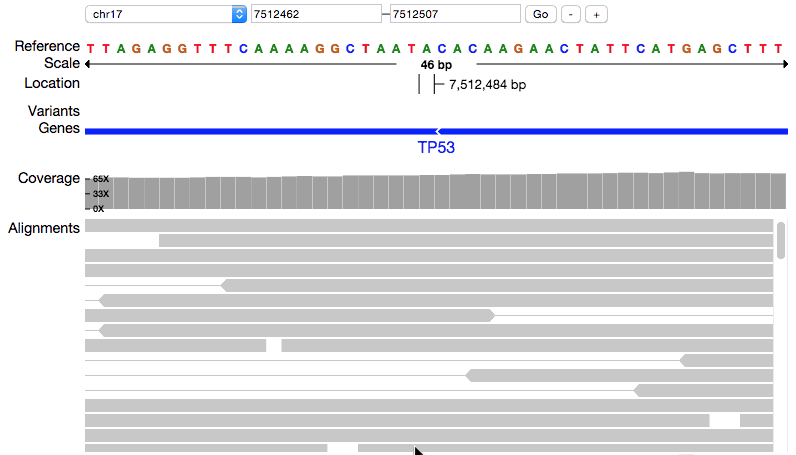SVG→Canvas, the pileup.js Journey
13 Oct 2015Modern web browsers provide two main APIs for graphics: SVG and canvas. The relative merits of these two technologies have been discussed at length. We’d like to add our experiences with pileup.js to the conversation. In this post, we’ll explain why we chose to migrate from SVG/D3 to canvas and look at the data-canvas library we built to ease the transition.
pileup.js is a library for visualizing and exploring genomes in the browser:

When we introduced it three months ago, we touted the merits of SVG:
By using SVG, we allow the tracks to be styled and positioned using CSS. This facilitates complex layouts and is more approachable for web developers than custom styling systems.
Styling with CSS is one advantage of SVG but there are others:
- It’s easy to test: you can use
querySelectorto find SVG elements and assert that they have certain properties. - It works well with the browser’s event system, especially when used with D3’s event handlers.
- It’s inherently resolution independent, a big plus in the age of retina displays.
While we were generally happy using D3 and SVG, we weren’t altogether happy with the performance of pileup.js. Its frame rate while panning was noticeably worse than other genome browsers like Dalliance and IGV.
As an experiment, we rewrote a subset of the pileup track using canvas instead of D3/SVG. We didn’t try to do anything clever: on every frame we cleared the canvas and redrew the entire scene from scratch.
A few things struck us about this:
- The canvas code was considerably simpler than the D3 equivalent. Whereas D3 required elaborate keying and joining to keep our data and visualization in sync, the canvas code was stateless. It simply took data and drew a scene.
- Because the Flow type checker has canvas declarations, it was able to provide significantly better static analysis than it did for the D3 code, for which declarations do not exist.
The CPU profile showed a dramatic performance win. The D3/SVG pileup track had been the biggest CPU hog, using about 30% of cycles while panning. After migrating to canvas, it only used 2% of cycles. Migrating to canvas was a 15x speedup! This matches the experiences of other developers, who have found canvas to be between 10x and 200x faster than SVG.
In the face of a 15x performance win, our arguments for SVG no longer held much water: we needed to switch to canvas.
Switching to Canvas
To ease this transition, we set out to find libraries that made up for canvas’s drawbacks, e.g. difficulty in styling, testing and click-tracking.
There are many libraries which wrap the canvas tag in something a bit more stateful. For example, fabric exposes Rect and Circle classes which get rendered onto the canvas.
Mapping our data objects into a permanent hierarchy of visual objects would require a different coding style, however. This is essentially what D3 does with its joins and selections. We wanted to preserve the simple character of the native canvas code.
Data Canvas
“All problems in computer science can be solved by another level of indirection.”
We came up with a simple solution which we’re calling the Data Canvas. We augmented the browser’s built-in canvas rendering context with two methods:
DataCanvasRenderingContext2D extends CanvasRenderingContext2D {
pushObject(o: any): void;
popObject(): void;
}
These maintain a stack of objects which are currently being rendered. We call this the “data stack”. Here’s what the stack looks like for a simple drawing:

While each object is being rendered, it sits on the data stack. Since re-rendering whole scenes is cheap on a canvas, we can easily perform other useful functions in the data stack while it renders objects by swapping in custom “contexts”:
- A context which records all calls allows us to write tests which assert that particular objects or shapes were drawn to the canvas (rather than checking the color of individual pixels).
- A hit-testing context allows us to determine which objects were on the stack when a particular point was filled or stroked. This makes it possible to determine what was clicked.
Check out the data-canvas README for a tutorial and a more in-depth treatment of this approach.
Results
After migrating all of our visualizations from D3/SVG to canvas, we were able to achieve a roughly a 5x improvement in frame rate while panning. We found the resulting code to be simpler than our D3 code, with less need to build temporary data structures and keys for use as D3 data.
While we’re happy with the improved speed of our visualization and clarity of our code, there are still some shortcomings of this approach:
- We had to move our styles from CSS into a JavaScript module.
- We need to build in resolution independence ourselves.
- We need to build transitions without D3.
As we continue developing data-canvas, we hope to find solutions to all of these.
If you’re using canvas in your web application, please give data-canvas a try. Please visit the github repo, file issues in its issue tracker and ask us questions on its gitter channel.
